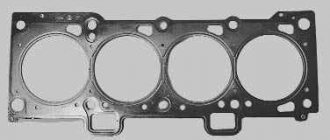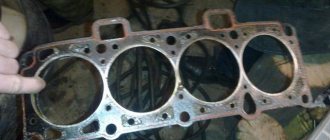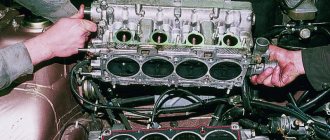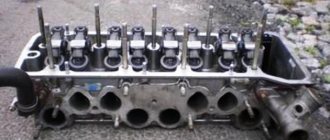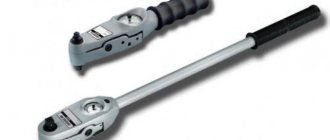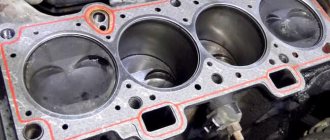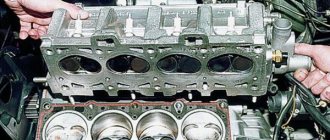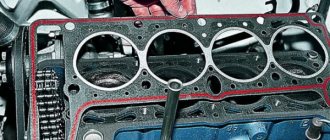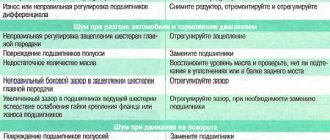Tools:
- Torque wrench
- Phillips screwdriver
- Flat screwdriver
- Pliers
- Key for 8
- Key for 10
- Socket wrench 13
- Open-end wrench 17 2pcs
- Socket wrench 17
- Socket wrench 22
- Socket wrench
- Socket wrench extension
- Head for socket wrench 8
- Head for socket wrench 10
- Head for socket wrench 13
- Head for socket wrench 17
- Socket for 13 E-Torx socket wrench
- Ratchet wrench scraper
Parts and consumables:
- Engine head gasket
- Engine valve cover gasket
- Chain tensioner gasket
- Sealant
- Coolant for topping up
- Camshaft lock washer Sandpaper 180-240
Note: The cylinder head gasket is replaced if it is damaged.
What is a cylinder head and its functions in a car engine
To ensure that the connection between the head and the cylinder block itself is sufficiently tight and airtight, a gasket is used. It performs three functions:
- seals the cooling system channel;
- prevents oil leakage;
- distribution - the cylinder functions normally, as a result of which the mixture of gasoline and air does not leak out.
The seal is used only once and is changed during any engine repair. You can use the following types - asbestos, non-asbestos, steel. Each gasket is good in its own way: metal gaskets distribute mechanical stress well, asbestos gaskets are more elastic and can withstand high temperatures.
You will need the following equipment: a 10 mm wrench, pliers and a flathead screwdriver. Different cars have their own design features, engine models and bolt patterns. It is impossible to create the same algorithm for all machines. Let's look at exactly how to do this with your own hands.
Purpose of the block head
This device is intended in the design of gasoline engines to perform the following functions:
- Supplying hot mixture to the cylinders;
- Exhaust gas removal;
- The gas distribution mechanisms are being based;
- Production of a chamber in which the combustible mixture is burned and compacted;
- Implementation of dynamic charge characteristics;
- Supply and drainage of oil, which is intended for the normal functioning of the timing mechanism.
Replacing the cylinder head gasket on cars
General rules suitable for any car, including the Chevrolet Niva:
- When disassembling, mark all attached parts with a marker - this way you will not get confused during the reverse process;
- when purchasing a gasket, buy exactly the type recommended by the engine manufacturer;
- be sure to remove any oil deposits on the fastening bolts;
- perform half or one turn when loosening the bolts to reduce the pressure;
- The cylinder head is assembled using special bushings;
- The bolts are finally tightened with a special wrench very carefully so as not to twist.
After replacing the gasket, carefully observe to see if there are any signs of leakage to ensure that it is properly replaced on the Chevrolet Niva.
Replacing the cylinder head gasket on a Niva Chevrolet car
- We remove the battery wiring and drain the antifreeze.
- We free the carburetor from cables and hoses.
- We dismantle the controller with voltage wires.
- Carefully remove the starter screen and heater tube from the manifold.
- Remove the antifreeze temperature sensor.
- Remove the brake booster hose.
- Remove the hoses from the cooling system and heater.
- Disconnect the camshaft and valve levers.
- We dismantle the chain and secure it.
- We unscrew the fasteners and remove the cylinder head with the pipe, carburetor and manifold.
According to reviews from Chevrolet Niva owners, you need to pay attention to the following subtleties:
- you should buy a metal seal as it is more durable and of higher quality;
- If the head fastener does not unscrew, you need to tap it with a hammer - this way you will minimally damage the surfaces and the key will not turn.
As you can see, replacing a gasket is not an easy task; you can do it yourself only if you have good general technical knowledge, skills and abilities. Remember, this is still the engine, the main part of the car. Before you do this, study the engine diagram well, the features of your car, do everything slowly, preferably in the morning with a fresh mind, because replacing a gasket is a feasible thing, but it requires attentiveness, scrupulousness and accuracy.
Any engine sooner or later requires repair, especially when the car has to be operated in difficult conditions, which is important for jeeps, which is what the Chevrolet Niva is.
Checking and replacing air flow sensor ZMZ 406
sensor - thermopneumatic flow meter IVKSH 407282000, installed in the intake system after the air filter.
The sensor determines the amount of air entering the cylinders while the engine is running.
We remove the injectors for inspection or replacement.
Relieve the fuel pressure in the power system.
Four fuel injectors are installed in the cylinder intake manifolds. The injectors open based on a signal from the control unit, injecting fuel in accordance with engine operating cycles
When should you change the cylinder head gasket?
Such work will have to be done when the gasket is damaged. These could be cracks or holes in the gasket. If damaged, the car owner will observe the appearance of air in the cooling system . This will also be indicated by the bubbling of antifreeze.
Crack in the cylinder head gasket.
You will also need to change the gasket when there is not enough compression in the combustion chamber. In this case, the gasket may simply wear out and will no longer be able to perform its functions. Also, when cracks appear, antifreeze will enter the combustion chamber, which will lead to unstable engine operation.
The cylinder head gasket on the Shniva burned out.
In all of the above cases, replacing the gasket will be simply necessary . If you do not replace it in time, the consequences can be dire.
Video about the signs of a broken cylinder head gasket in a Niva Chevrolet
conclusions
If you do not have sufficient skills in this work, it is recommended to seek help from specialists at a service station.
We carry out the work on an inspection ditch or overpass. We remove the cylinder head complete with throttle assembly, receiver, fuel rail, intake pipe, exhaust manifold and thermostat. Relieve the pressure in the fuel rail (see Replacing the fuel filter). Disconnect the wire terminal from the negative terminal of the battery. Drain the coolant from the radiator and cylinder block (see Replacing the coolant). We remove the tips of the high-voltage wires from the spark plugs (see Checking the condition and replacing spark plugs) and remove the oil level indicator from the guide tube. We disconnect the tip of the throttle valve drive cable from the throttle assembly sector (see Removing the throttle drive, replacing the cable). Then we disconnect from: • the receiver - the throttle cable and the brake booster hose (see Replacing the receiver gasket); • cooling jacket outlet pipe - upper radiator hose (see Removing and installing the engine); • thermostat - lower radiator hose and fluid supply hose to the coolant pump (see Replacing the thermostat); • cylinder head pipe and heater radiator outlet pipe - heater radiator hoses (see Removing and installing the engine); • canister purge valve - a tube connecting the valve to the adsorber (see Removing elements of the fuel vapor recovery system); • fuel rail - fuel supply hose (see Removing the fuel rail and injectors); • exhaust manifold - exhaust pipe (see Removing the exhaust pipe) and starter shield (see Replacing the gasket of the intake pipe and exhaust manifold); We disconnect the engine management system wiring harness connectors from the injector wiring harness, the control system coolant temperature sensors and the coolant temperature indicator, the crankshaft position sensor, the phase sensor, the idle speed controller, and the canister purge valve (see the relevant sections). Remove the cylinder head cover. Turn the crankshaft until the mark on the camshaft sprocket aligns with the mark on the camshaft bearing housing (see Removing the camshaft and valve drive levers). Remove the hydraulic timing chain tensioner (see Removing the hydraulic timing chain tensioner).
We remove the sprocket from the camshaft toe and tie the chain with wire. Remove the camshaft and valve drive levers (see Removing the camshaft and valve drive levers).
Using a 13mm socket, unscrew the cylinder head mounting bolt located next to the upper mounting bolt of the generator bracket.
We turn off the E16 head...
...ten bolts securing the head to the cylinder block... ...and remove the bolts.
Remove the cylinder head assembly with thermostat, throttle assembly, receiver, intake pipe, fuel rail and exhaust manifold. The cylinder head can also be removed from the engine by first removing the intake pipe and exhaust manifold (see Replacing the intake pipe and exhaust manifold gasket).
Remove the cylinder head without the exhaust manifold and intake pipe.
Remove the cylinder head gasket. Before installing a new gasket, clean the mating surfaces of the head and cylinder block from remnants of the old gasket, deposits and oil. Using a syringe with a needle or a rubber bulb, remove oil and coolant from the holes in the cylinder block for the head bolts. We install the gasket and cylinder head using two centering bushings. When installing the head on the cylinder block, we thread the chain with wire through the hole in the head. Having installed the cylinder head bolts, tighten them in the order shown in the figure.
Procedure for tightening the cylinder head bolts. To ensure a reliable seal and avoid tightening the bolts during vehicle maintenance, we tighten them in four steps: 1st step - tighten bolts 1–10 with a torque of 20 N m (2.0 kgf m); 2nd step - tighten bolts 1–10 to a torque of 69.4–85.7 Nm (7.1–8.7 kgf m), and bolt 11 to a torque of 31.4–39.1 Nm ( 3.2–4.0 kgf m). Then we turn bolts 1–10 by 90° (3rd step) and another 90° (4th step). We carry out further assembly in reverse order.
Checking the condition before starting work
It is faster and more profitable to check the need to replace the shaft on models 2121, 21214 and any other domestic Niva yourself - as well as the installation and dismantling process itself. Moreover, even if the camshaft does not change, it will still have to be removed and repaired (grinded, straightened, balanced). Parts that are severely worn, cracked, or bent must be replaced with a new one.
Preparing for replacement
Before removing the camshaft to replace it or check its condition prepare a set of tools consisting of:
- wrenches;
- torque wrench;
- chisels;
- socket heads for 10, 13 and 17.
At the first stage of shaft removal work, the following actions are performed:
- 1. Removing the negative terminal from the Niva 21213 car battery (2121 and any other domestic modification of this car);
- 2. Removing the cylinder head cover;
- 3. Install the camshaft in a position where the mark on its sprocket coincides with the corresponding protrusion on the bearing housing. And the mark on the pulley is with the protruding part of the shaft drive.
In what cases is it necessary to change the cylinder head gasket on a Niva?
In principle, the element of the main cylinder block in question does not have a certain resource, that is, the gasket is replaced when it is damaged, which, however, usually occurs after 60,000 or 80,000 km. A breakdown is indicated by:
- air entering the antifreeze circulation system;
- lack of operating pressure in the combustion chamber of the air-fuel mixture;
- the presence of coolant in the lubricant or, conversely, the latter in the antifreeze (an oil film appears in the expansion tank).
All these problems lead to unstable operation of the Chevrolet engine.
In these situations, the gasket must be replaced immediately.
Draining antifreeze in Chevrolet
This is the first stage that is performed when replacing a damaged Niva gasket. Initially, you need to remove the mudguard and the lubrication sump housing - they are located in the engine compartment.
Now you need to get rid of the antifreeze remaining in the cooling system of the engine itself. To the left of the cylinder head, near the ignition unit, there is a separate drain hole. Place a container under it and unscrew the plug with a 13 key.
When the liquid flows out, tighten the radiator cap and cylinder head. In the latter case, a force of at least 25 N∙m will be required.
Search
How to change the cylinder block gasket in a Chevrolet ?
Sooner or later, the engine of any car will need maintenance or repair. Especially if the car is operated in difficult and extreme conditions, which is especially important for domestically produced SUVs. Now you will learn how to do it, Chevrolet Niva,
spare head gasket, balloons and what to prepare.
When should I change my cylinder head gasket?
Cylinder head gaskets need to be replaced
Niva Chevrolet
and, accordingly, the need for its tightening torque arises in some cases.
Replacing the Chevrolet niva cylinder head gasket: video. If damaged, the gasket in the vehicle must be replaced. This means that there are cracks and breaks in the structure the cylinder cover . 3 grenades. 3.1 video about Chevrolet Drive on Chevrolet Niva:. In this case, field owner Chevrolet
A gas rupture will occur in the cooling system, as evidenced by regular drilling of antifreeze.
Tightening cylinder head screws for Niva Chevrolet
You may also like
- Replacing the Timing Belt Daewoo Matiz 0 8 Daewoo Matiz F8CV EngineThe compact hatchback Daewoo Matiz was released in 1998, thanks to its low gas consumption, maneuverability and reliability, the car gained considerable popularity. Daewoo Matiz 0.8 engine. The simplest power supply is installed...
- How to turn on Webasto BMW E39
Diagram of laying iron pipes along the engine: the harness runs in the engine compartment, etc. Connection diagram of the upper air heater with a combined timer. And if anyone has it, write a letter. I took the diagram from the website from the article “Understand”. Install...
What's Faster: BMW or Mercedes?
German quality has long been a household name in the automotive industry. This is especially true when it comes to premium cars from Audi, BMW and Mercedes. The last two will be discussed in the current article. These cars have a lot in common…
Replacing Front Pads Daewoo Nexia
Features of the Daewoo Nexia brake system On Daewoo Nexia cars, the manufacturer provides for the installation of two independent brake systems. Works. A basic system that is designed to provide braking during any vehicle movement...
Replacing the E46 Rear Wheel Bearing
Replacement of rear hub bearings Rear wheel hub assembly 1. Cover 2. Axle axle 3. brake drum 4. hub 5. Bearing 6. Oil seal7. bolt securing the axle to the lever 8. Bearing 9. Washing machine 10 is a nut 11. Washer for the switch…
Repairing the Rear Beam of a Peugeot 405 Do-It-Yourself
Peugeot 205 1.8 XLD ›Logbook› Repair of rear Peugeot Beams part 1: make yourself a special Peugeot tool Many Peugeot / Citroen owners at some point were faced with the need to repair the rear beam, and I was no exception. At first…
In addition, it is necessary to replace the Niva Chevrolet head gasket due to insufficient compression in the combustion chambers. The gasket may have worn out and will no longer be able to do its full job. In addition, if cracks appear in the cylinder
antifreeze will enter the engine fluid and vice versa.
In these cases, replacing the cylinder head gasket is mandatory. If you start this business, things can get even worse. Therefore, if in your area Chevrolet
At least one of these features as described above has been identified and the gaskets
cylinder heads .
Replacement process and tightening torque
Tools you need
To perform this work, replace head gasket Niva Chevrolet
and when tightening the cylinder head bolts, be prepared:
Calculator for converting pressure in bar to MPa, kgf and psi
Online converter to convert pressure in megapascals (mPa) to kilograms (kgf cm2), bar, pound force (psi) and atmosphere
The Chevrolet Niva engine head is not particularly different from other VAZ heads. On VAZ 21213 engines, hydraulic compensators were installed from the factory to avoid problems with valve adjustment. But on our engine head, someone has already replaced the hydraulic compensators with ordinary toy soldiers with manual adjustment of valve clearances.
The engine was disassembled due to the formation of an emulsion in the lubrication system. The cylinder head was being crimped and a rotten cooling system plug was discovered. The formation of holes in the cylinder head plugs is a very common problem in VAZ engines. This happens mainly due to poor quality coolant. Car enthusiasts save their money and purchase low-quality antifreeze, and then wonder why their power unit failed so quickly... After the above manipulations, the engine was reassembled and continued normal operation
This photo report will show step by step the process of assembling the Chevrolet Niva cylinder head and its installation on the engine block. The engine head plugs were welded, the head was planned, and the valves were ground in.
Cylinder head: purpose, design, removal and installation
Cylinder head manual: purpose, design, removal and installation
Without what parts will an internal combustion engine not function? Unfortunately, there are a lot of such parts, and they all perform their functions that are important for the operation of the internal combustion engine. This article will talk about such a detail in the design of the Chevrolet Niva engine as the cylinder head. What is its purpose and how does it function, as well as the main breakdowns and the procedure for replacing the cylinder head of a Niva Chevrolet SUV.
The cylinder head is one of the main parts of the design of an internal combustion engine, but not only that. A diesel engine also has such an element in its design, only there are some differences between them in the functions performed (type of fuel, compression ratio), but that’s another story. This article is devoted specifically to the head of the gasoline engine, which is equipped with all cars of the Chevrolet Niva line.
This device is intended in the design of gasoline engines to perform the following functions: 1. Supplying hot mixture to the cylinders; 2. Exhaust gas removal; 3. The gas distribution mechanisms are based; 4. Production of a chamber in which the combustible mixture is burned and compacted; 5. Implementation of dynamic charge characteristics; 6. Supply and removal of oil, which is intended for the normal functioning of the timing mechanism.
An important function is also to ensure that the vehicle meets environmental standards and the emission characteristics of hazardous substances. Thus, from the purpose of the cylinder head it is clear that this element is indispensable in the operation of the engine, and therefore the car as a whole.
What does the device consist of?
Having found out the irreplaceability of this device, it is worth understanding what it is and what elements it consists of. So, the cylinder head on a Chevrolet Niva is a rectangular engine cover, which is made of aluminum and its alloys.
It is rare to find cast iron cylinder heads on older models; most often they were installed on diesel engines.
The cover design includes:
1. valve rocker arm; 2. hydraulic compensator; 3. valve seats; 4. guide bushings; 5. springs that ensure the valves return to their original position; 6. spark plugs; 7. intake and exhaust valves.
Side view of the product
The cover with all the above parts of the Niva Chevrolet engine is called the cylinder head.
So, the functioning of the head is determined by the following actions:
1. When the engine starts, the rod is pushed by the camshaft. 2. The rod exerts a mechanical effect on the hydraulic compensator and subsequently on the rocker arm. 3. The rocker arm acts on the opening of the fuel-air valve. 4. When this valve opens, the air-fuel mixture is supplied to the combustion chamber, where it ignites. 5. Combustion is ensured by the presence of spark plugs, which produce a spark at a certain time. 6. The exhaust valve diverts the ignited mixture in the form of gases into the exhaust manifold. The cycle repeats.
The cylinder head of a Niva Chevrolet car is designed to operate four pistons, and, therefore, the same number of combustion chambers. The functioning of the cylinder head is often accompanied by the appearance of various types of malfunctions that require at least prompt elimination. What malfunctions may occur in the head on a Niva Chevrolet car and how they can be eliminated are described in the next subsection.
Cylinder head malfunctions on Niva Chevrolet
For the convenience of considering problems that arise during the operation of the cylinder head, the information is included in the table.
| Number | The essence of the problem | Causes | What are the consequences? |
| 1 | Damage to the connection between the head and the air manifold | There is no seal at the connection to the air manifold | Gas-dynamic properties are violated. Fuel has the property of not burning completely. Car power decreases |
| 2 | The seal between the gasket and the cylinder head is broken | The clamping screws are not tightened properly | There is no cleanliness of the surface treatment of the cylinder head for the gasket without ensuring the tightness of the connection |
| 3 | The seal between the device and the exhaust manifold is broken | There is no tightness of the joint between the head and the exhaust manifold | There is no flatness tolerance for the gasket |
| 4 | Gases escaping through the joint seal | Insufficient coupling of block rigidity with head supports | Disruption of the working process, loss of power, increased noise, instability of the motor |
| 5 | Reduced tightness between the cylinder head and the intake and exhaust valve bushings | The positions of the holes for the guide bushings do not provide a tight connection | Engine compression decreases, oil and fuel consumption increases, and problems arise with starting the engine. |
| 6 | The tightness of the intake and exhaust valves is broken | The geometric parameters of the wall of the seat under the saddle are not maintained | Compression decreases, engine starting becomes difficult |
If such faults are identified, they can be eliminated. But there are also more serious faults that only entail replacing the cylinder head. Such malfunctions include:
1. Violation of the tightness of the cooling system channels. Appears as a result of engine overheating. The crack most often forms in the water jacket, causing antifreeze to mix with the engine oil, causing serious problems. 2. Warping of the mating surface to the block. The consequence of this malfunction is the leakage of coolant not only into the engine, but also outside. Head warpage is virtually impossible to correct and requires replacement of the part.
The procedure for disassembling and assembling the cylinder head on a Chevrolet Niva
When determining a malfunction, it is necessary to carry out the procedure of removing the head for its subsequent replacement on a Niva Chevrolet car. First of all, you need to arm yourself with a standard set of tools and get started.
You can remove the cylinder head from a Niva Chevrolet SUV as follows:
1. All work is allowed to be carried out exclusively on a cold, “cooled down” engine. 2. Power from the battery is disconnected. To do this, you need to remove the minus terminal from the device. 3. There is no need to remove the engine from a Chevrolet Niva, since the cylinder head is located in the upper base of the engine, so it can be removed this way. First of all, the antifreeze is drained from the radiator. 4. The throttle valve drive cable is removed. 5. Next you need to remove the camshaft along with the bearing housing. 6. The valve regulators are removed, and then their supports.
Removing the camshaft 7. The ramp providing oil supply to the supports is dismantled. 8. A wiring harness is connected to the throttle position sensor; it is necessary to disconnect the terminal block of these harnesses. 9. The pads are similarly disconnected from the temperature sensor with the idle air control. 10.The power supply wires of the injectors are also de-energized by disconnecting the plastic clamp. 11. The knock sensor is de-energized. 12.The plastic tie clamps holding the wiring must be cut and the cables moved to the side. 13.The supply wires of the Chevrolet Niva spark plugs are removed. To do this, you need to grab the rubber sheath and pull it.
